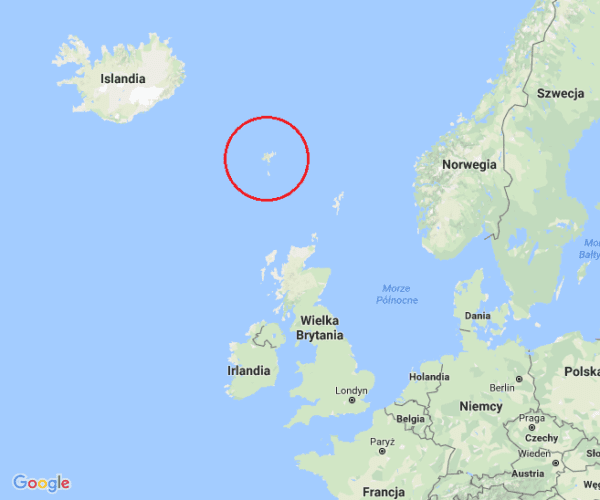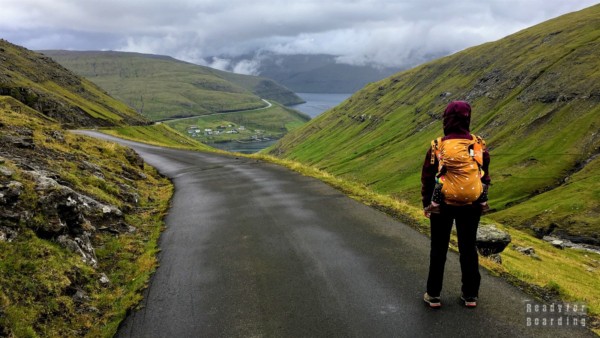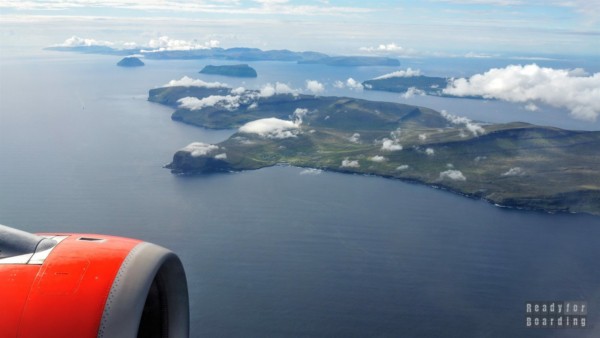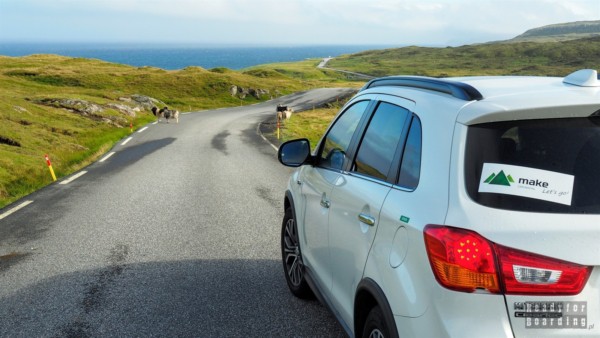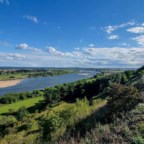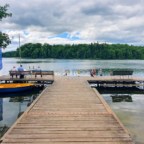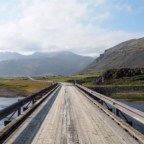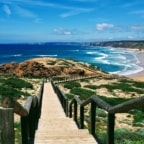The Faroe Islands are an archipelago full of sheep, rain and wool sweaters. Some may associate it only with the famous slaughter of grindwalas, while others may associate it with one of the safest yet most expensive places in Europe. How is it in reality?
In the next few posts, we will introduce you to this remote archipelago and dispel some myths….
What will we associate the Faroe Islands with?
First of all, with beautiful landscapes, wilderness and surrounding silence from everywhere.
We haven’t been to such a scenic and safe place since we went to Iceland(the Azores are right next on the podium). And one wants to immediately start describing everything, praising and inspiring, but time will come for everything :)
We were in the Faroe Islands for a week – on the one hand, it’s enough to see the most beautiful places, and on the other hand, it’s definitely not enough to see everything, walk most of the trails, learn more about the culture, about the Farer people (or Farers as you prefer), see every island, etc. We’ve seen a lot, we’ve also read a lot and still we still have some sort of insufficiency. However, let’s start at the beginning.
Table of contents
The Mysterious Faroe Islands
The Faroe Islands are a small archipelago in the Norwegian sea, above the UK. This is important because many people have no idea where these islands are located at all. They may sound a bit exotic, and in fact they are very close (a flight from Copenhagen takes about 2 hours).
Although they are a dependent territory of Denmark, they are not part of the European Union and the Schengen area, so those coming from Poland need a passport (!).
The archipelago includes 18 islands of volcanic origin, but this does not mean that we will see extinct volcanoes here. Instead, we will see majestic cliffs (the highest in Europe!), fjords, valleys, fishing villages in coves, plenty of waterfalls. Views not from this earth guaranteed (unfortunately, clouds and rain are also guaranteed).
Why the Faroe Islands?
There were plenty of reasons to go to Føroyar .
It started with one beautiful photo we came across on Instagram. It was a photo to which the reaction was along the lines of: Oh my gosh, where is it and how much do airline tickets cost there! – do you have that too? ;)
>>> Polecamy również nasz eBook "Wyspy Owcze" za jedyne 19,99 zł! Wszystko w jednym miejscu, a w nim 149 stron pełnych inspiracji, opisów i praktycznych porad.
Later, we started looking, looking through photos, reading. With each new website and blog report, we were more and more convinced that we would fly there no matter what. The whole thing was topped off by Remigiusz Mroz’s (a.k.a. Ove Løgmansbø) trilogy about the Faroe Islands, and you wouldn’t know when and we were already reaching for the credit card to pay for the plane ticket.
Why “Sheepish? “
Do you remember when we ineptly searched for canaries in the Canary Islands? Fortunately, sheep are plentiful in the Faroe Islands – or at least that’s what it initially seems to any tourist visiting the archipelago. Name obliges.
As soon as we got into the car the first animals appeared on the side of the road which quickly ran across the road. And such views accompanied us throughout the trip. By the roads, on the trails, around the house – sheep and rams everywhere. No wonder, there are more of them than inhabitants of the archipelago!
The population of the Faroe Islands is over 50,000, and there are 75,000 – 78,000 sheep here (efforts are being made to keep the number of sheep just within these limits). And it is not enough! Not enough to feed the Faroese community. Increasing this number can have a dire effect on the local ecosystem, so mutton is often densely imported from Iceland and New Zealand (yes, you read correctly – from the end of the world).
Popular, of course, is sheep’s wool, which is used to make sweaters, hats, gloves, so popular in souvenir stores (correction: in stores near the tourist information, because we could count souvenir stores on the fingers of one hand ;))).
However, this is not the end of ovality. Only the Farers could have come up with the idea to measure a unit of area with sheep. More precisely, it is not a fixed value, but what area is able to feed 32 sheep! For the record, the name of this measure is mørk.
A challenging destination
While we’ve written about the Azores as not being for everyone, the Faroe Islands are an even more specific destination. Who will be fulfilled here? Definitely walkers. This is a country for active people who are not afraid to walk a few or a dozen kilometers to see spectacular cliffs, cliffs or waterfalls. Moreover, they are not afraid to go often in the rain, mud, herding a bunch of sheep and crossing fences on ladders.
Add to this the trails, which are not there, as no signage can be found along the route, only a lightly trodden path (and that too in favorable winds). Well, then, perhaps by now it is clearer what I mean ;)
Of course, there are quite a few places to which you only need to walk a piece, and many can be reached by car, but what fun is it to stop only at viewpoints?
There is also no denying that the Faroe Islands are expensive. If you already come here, you have to expect big prices for accommodation (especially in high season) and car rental (we advise against getting around by bus). You have to pay a lot for food (especially dining out), but the basic products in the stores are not cosmically expensive.
And we by no means want to discourage you :) Simply by flying to Føroyar you need to be aware of these “inconveniences” or “difficulties”.
Weather in the Faroe Islands
Of course, it is also not a place where sun and beach lovers come ;) The temperature in August is constant: approx. 12-14 degrees, but it must be said that when the sun appears the perceptible can be much higher. It is said that it rains 400 days a year in the archipelago. Well, no ;) A rainy day is considered a day on which at least some rain has fallen, so don’t cross out your chances of sunshine.
The weather here changes like a kaleidoscope, and it’s hard to predict what weather awaits us beyond the tunnel or on another island (fortunately, live cameras come to our aid). We were very lucky – we hit excellent weather for several days (yes, on the other hand there were several rainy and cloudy ones, but we are optimists who see the glass half full).
How to get to the Faroe Islands?
The easiest way to get to the archipelago is by plane, but there are also ferries (they go from Denmark to Iceland, so you can combine our trip with Iceland as well).
We chose the faster option with a plane. The only airport in the Faroe Islands flies several planes a day, and that of two airlines: SAS and Faroese Atlantic Airways. We flew SAS airline from Warsaw to Copenhagen, and from there to Vágar Airport (named exactly the same as the whole island).
The flight from Warsaw took about an hour, and about two hours to the Faroe Islands. Once again, the worst thing about the whole trip was the long transfer, because the flights themselves were very comfortable and efficient. A ticket for one person cost us 1,600 zlotys (without any promotions).
Vágar Airport is considered a dangerous airport, especially due to unfavorable winds. We have read that it is the weather conditions that make several approaches take place, but fortunately we did not have the opportunity to see for ourselves. Instead, we had the opportunity to enjoy the beautiful views from behind the plane’s windows, as the weather was excellent as ordered (we saw Lake Sørvágsvatn, among other things).
Although, by the way, the Madeira airport impressed us more in terms of the difficulty of landing ;)
The Faroese airport is tiny and the control tower is miniature – but that’s more than enough to handle nearly 300,000 passengers a year (2016 figures [source]). Interestingly, despite the fact that the archipelago is not part of the Schengen zone, no one checked passports on departure and arrival (except for baggage claim).
Oh, while at the airport, pay attention to the store located here – souvenirs are cheaper than in other places on the Islands, you can also safely buy drinks (including spirits) because their prices are attractive.
After landing, we were left to pick up the car and hit the road. Unfortunately, the problem occurred at the first point. Well, we could not locate our car rental company anywhere. There was only one window, but it did not handle this company, from which confirmation we had. We went outside and sought help from an airport employee, who surprisingly had heard nothing about the company. Then we started to get a little stressed.
We realized that renting a car outright might border on a miracle, and if we succeeded, it would cost us as much as five flights to the Faroe Islands. Fortunately, an employee at the airport, an elderly, kind-hearted gentleman, got very involved and started calling his contacts. It turned out that the rental shop existed (ufff), and the keys were waiting for us at the Tourist Information Center, which we passed as several people were waiting there. The few people in line were nothing compared to the queue for other rental companies, so overall we came out better off :)
By the way, we highly recommend you our rental company. It is a typical local rental company (exceptionally this time we did not book through Rentalcars), it is simply called make.fo:)
Once we picked up the car we were left to buckle up, hit the road and watch out for those hairy creatures just waiting to jump under the oncoming car.
Summary
Don’t be discouraged! The Faroe Islands are the coolest place we’ve seen this year! In upcoming posts you will see why we liked them so much!
See all our posts about the Faroe Islands!


